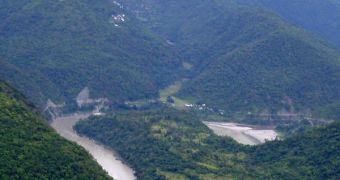The international scientific community acknowledges that global warming and climate change will have a devastating influence on the world's glaciers and ice-capped mountain ranges. The same is expected to take place in Asia as well, where large amounts of melting glaciers could spell disaster for the areas downstream. Previous estimates had shown that river volumes will increase due to melt water from the glaciers, to the extent when extensive floods will become a real and distinct possibility. But new data appear to dispute those models, showing that the influence of global warming will most likely be more reduced than initially anticipated, Nature News reports.
High mountains in Central Asia, including the Himalayas, will be most affected, though the exact extent is not yet known. Modeling or simulating such scenarios is a very tricky business, as experts need to account for numerous factors. At times, some of the things that influence local temperature are not even known, which means that, when they are discovered, the entire models need to be devised again. In the case of Asian water supplies, scientists at the Boulder Colorado-based US National Snow and Ice Data Center (NSIDC) found that declining glaciers would have a more reduced influence than previous predictions had stated.
“There clearly were some misunderstandings,” says NSIDC climatologist Richard Armstrong, referring to the report released by the Intergovernmental Panel on Climate Change (IPCC) a couple of years ago. The document held that the Asian continent would face dire water restrictions in the future, and that most of these ill-effects would be caused by global warming and ice melting. The new data were derived from studies the American team carried out on the five major rivers in Asia: the Indus, the Ganges, the Brahmaputra, the Yellow River and the Yangtze River. The group looked at how much melt water was in these basins, and determined that its prevalence was lower than anticipated.
In other words, the group says, there is more water from monsoon-related rainfall than from melting glaciers. However, the Indus river broke the pattern, exhibiting a melt water prevalence rate that exceeded that of rains by more than 150 percent. In other rivers, the difference was significantly less pronounced. The scientists say that global warming and climate change will nevertheless act on water supplies through two mechanisms – decreased glacier run-off, and modified water patterns. The latter will affect both rain and snowfall, and will have a more disturbing, long-term influence on the Asian continent.

 14 DAY TRIAL //
14 DAY TRIAL //